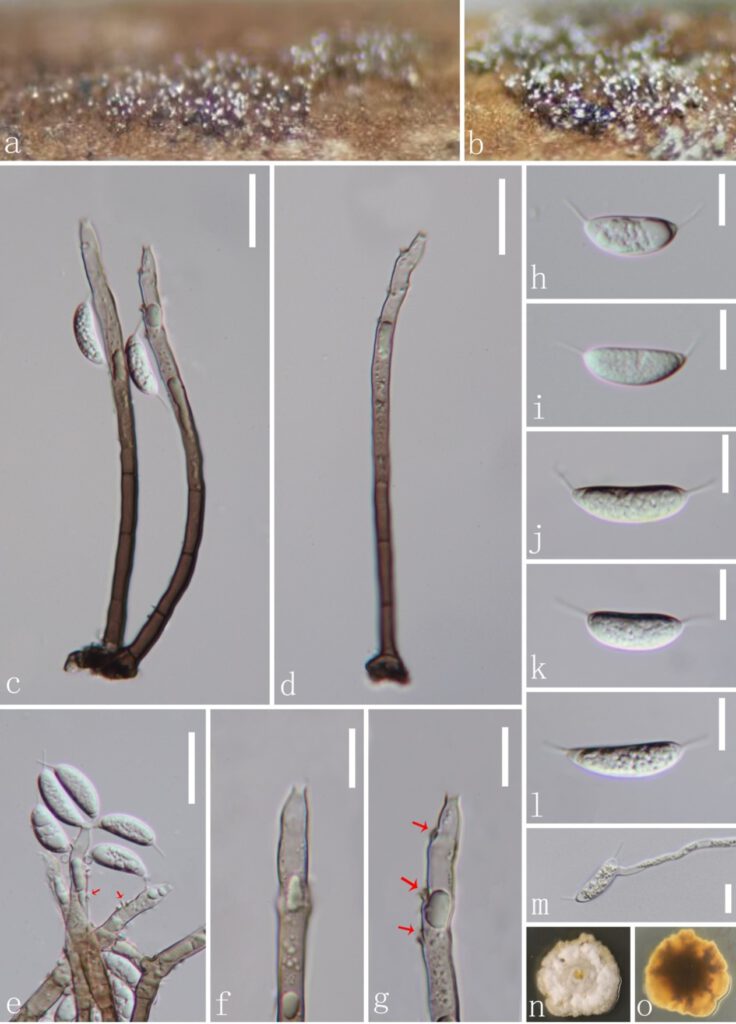Codinaeella hyalina J.Y. Zhang, Y.Z. Lu & K. D. Hyde, sp. nov. (Figure 5)
MycoBank number: MB; Index Fungorum number: IF; Facesoffungi number: FoF 11039;
Etymology: Referring to its hyaline conidia.
Holotype: HKAS xxxx
Saprobic on decaying wood submerged in freshwater habitats. Sexual morph: Undetermined. Asexual morph: hyphomycetous. Colonies on natural substrate superficial, effuse, mostly single, or arise 2-3 in groups from knots of hyphal cells, dark brown, with glistening mass of conidia at the apex of conidiophores. Mycelium mostly immersed, composed of pale brown, septate hyphae. Conidiophores 93–143 × 3.4–5.1 μm (x̅ = 121 × 4.4 μm), macronematous, mononematous, single or in small groups, erect, straight or slightly flexuous, smooth, dark brown at the base, becoming paler to subhyaline towards the apex, 2–7-septate, smooth, guttulate. Conidiogenous cells 23.6–68 × 3.2–5.5 μm (x̅ = 50.3 × 4.3 μm), mono- or polyphialidic, with discrete, lateral phialides, integrated, terminal, with up to lateral openings formed by successive sympodial elongation, cylindrical to cylindrical-lageniform, with funnel-shaped collarettes, brown at the base becoming subhyaline to hyaline towards the apex, smooth-walled. Conidia 15.9–21.6 × 5.8–7 μm (x̅ = 18.6 × 6.3 μm, n = 20), amerospores, aseptate, often unilateral ventricose, reniform, aggregated in large and slimy mass, rough-walled, hyaline, with hair-like and 4–7 μm long appendages at both ends.
Culture characteristics: Conidia germinating on PDA within 12 h. and germ tubes produced from conidia. Colonies growing on PDA, slow growth, reaching 20 mm diam. in 20 days at 25°C, circular, flat, with dense, white mycelium on the surface with undulate margin, from below olivaceous brown at the center, yellow at the edge and not producing pigmentation in culture.
Material examined – CHINA, Guizhou province, Zunyi city, Xishui county, Taolin town, Tianlong village, on submerged decaying wood in a freshwater stream, 13 February 2021, Jian Ma, TL24 (HKAS xxx, holotype; GZAAS22-0073 isotype), ex-type living culture, GZCC 22-0082. GenBank accession numbers: (LSU) xxx, (ITS) xxx.
Notes: Following BLASTn searches, the closest matches of our new isolate is Codinaeella minuta (strain 417E, ITS, MZ078594, 96.57% shared identity; strain ATCC 20960, LSU, OL654146, 99.08% shared identity). In the phylogeny (Fig. 1), our new isolate formed a separate clade, and basal to several species of Codinaeella with high boostrap support (98% ML/1.0 PP). Morphologically, our new isolate is mot similar to Cod. mimusopis in having macronematous, mononematous conidiophores, conidiogenous cell with lateral phialides and hyaline, aseptate conidia with filiform appendages at both ends (Réblová et al. 2021b; Crous et al. 2018). However, our new isolate differs from Cod. mimusopis in having wider conidiophore, and wider and reniform conidia (15.9–21.6 × 6–6.9 μm vs 16–18(–20) × 2.5–3(–3.5) μm). We therefore introduced our new isolate as a novel species within the genus Codinaeella based on morphological characters and phylogenetic evidence.

Figure 5. Codinaeella hyalina (HKAS xxxx, holotype). (a,b) Colonies on woody substrate; (c,d) Conidiophores and conidiogenous cells; (e–g) Conidiogenous cells (arrows indicate collarettes); (h–l) Conidia; (m) Germinating conidium; (n,o) Culture on PDA from above and below. Scale bars: (c–e) 20 μm; (f–m) 10 μm.
